In the Studio: Minimal Violence
Gear talk with the rising Canadian duo.
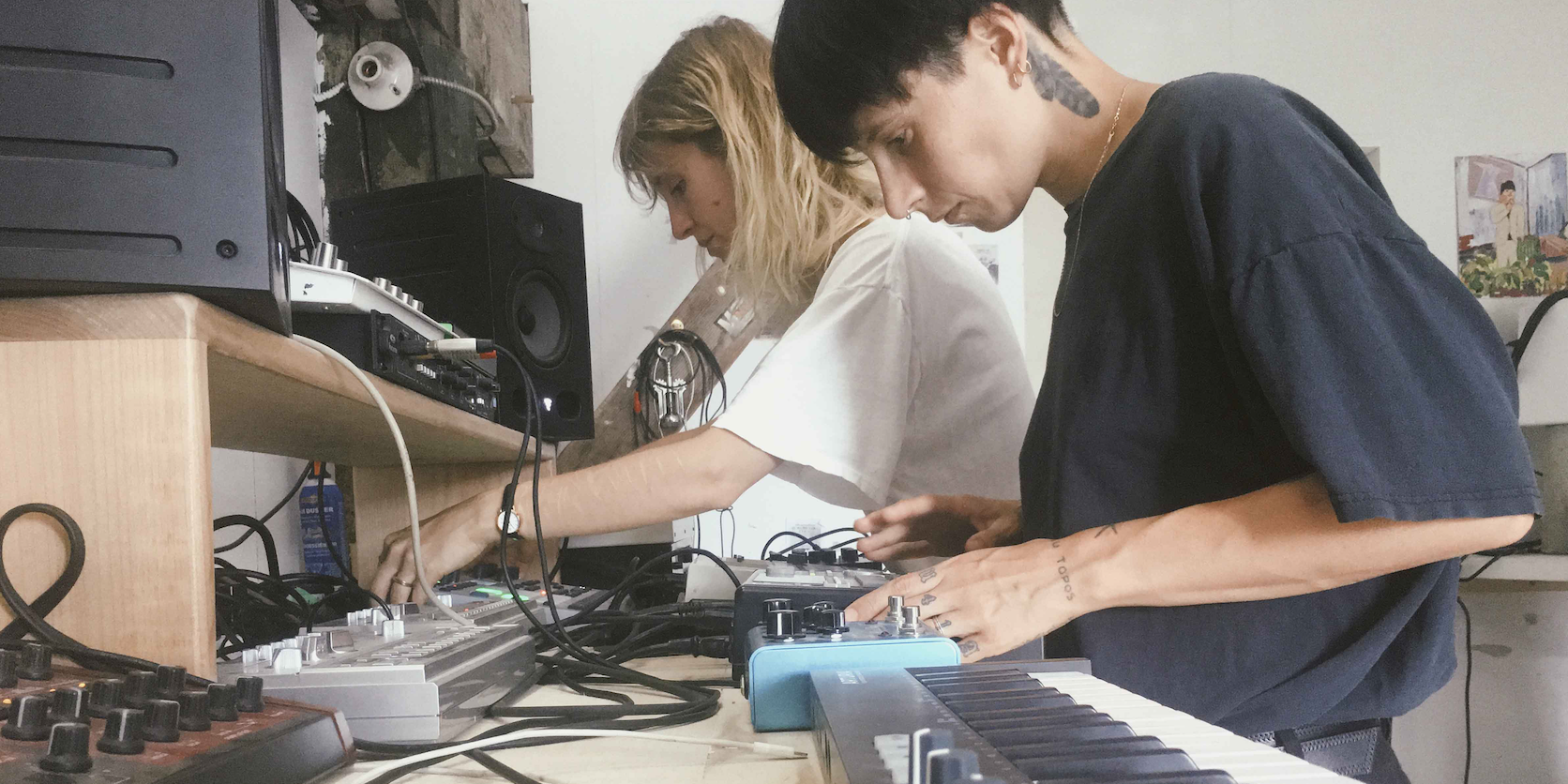
In the Studio: Minimal Violence
Gear talk with the rising Canadian duo.
Ash Luk and Lida P’s collaboration dates back to 2015, but the Canadian duo first met in 2013 while working together in a sandwich shop in Vancouver. As their relationship developed, so too did their urge to work together on something creative, perhaps something in writing or visual art, but their shared interest in music made this their artistic medium of choice. Lida, who studied drawing and critical theory at Emily Carr University of Art and Design, had a diverse taste in music, whereas Luk came from a punk background but divided her time in music between two projects: lié, a three-piece dark punk band; and a minimal synth project called //ZOO. This served as a backdrop to their experimentation, and together they ventured into more straight-up house and techno.
The fingerprints of Vancouver’s underground punk community are all over the duo’s work. They became known as part of the city’s Sacred Sound Club, a collective that champions experimental and noise sounds, and so began sourcing their first pieces of hardware gear—often no more than “a few din-sync linked synths and drum machines alongside a sampler and a casio we found next to a garbage can,” they explain. Listen to their work, from 2015’s Heavy Slave debut through the EPs on 1080p and Lobster Theremin, and their debut album, InDreams, via Ninja Tune’s Technicolour, and you can’t help but bask in the rough and ready sounds, referencing heavier UK rave, hardcore, and also brutalist EBM. Both aggressive and frenetic, dark and delirious, the Minimal Violence sound is a relentless assault on the senses, with jarring moments of disorienting chaos all held together by oppressive kicks and scattered breakbeats. It makes you want to move—really move.
InDreams is the most solid example of this. It’s harder than anything they’d put out on record before, made of several hardware jams (most exceeding 130 BPM) that had been received well in their live sets. As with much of their work, at times it can feel chaotic and overwhelming when listened to in private, but there’s something inside you that makes you want to hold on that little bit longer, to attune, and listen some more. The efficacy of their music in the club context is extreme—tracks like “June Anthem,” with its pop tropes, and “Last One At The Rave” will slay any dancefloor—but its otherworldly aesthetic, manufactured with non-conformist and uncompromising structures, ensure that its relevance in regular life is not lost.
Off the back of their album debut and a recent contribution to XLR8R+, we connected with them one afternoon in their studio, based in Deep Blue, an artist-run event space in Vancouver, as they mull over a move to Berlin and begin their search for a new home to continue making music.
What was it that drew you both to music, individually and collaboratively?
Ash: I can’t remember a time when I wasn’t drawn to music. I attribute this at least partially to my mother who, while growing up, was a promoter in a local legendary punk bar in Winnipeg, The Royal Albert. I’ve been playing in bands for years but making music with my partner, being creatively active together, and getting the opportunity to travel together seemed like the best possible idea.
Lida: I have to admit that making music was never something I was really drawn to on my own. Ashlee definitely has always had the advantage of being more in the comfort zone. However, I liked the challenge it presented. And I was also drawn to the machines, especially since MIDI enabled me to bypass my terrible lack of natural rhythm!
How did you acquire your first gear to begin making music?
Ash: The first piece I bought personally was a Juno 60, for //ZOO, my minimal synth project. I found one on Craigslist for CAD$600 which, at the time, seemed like a lot but it was a really great deal in retrospect. I remember lugging it around to play gigs with. I soon wanted a drum machine to pair it with and ended up getting a TR-606 so that I could use the sync to trigger the arp on the Juno.
Lida: Ashlee and I started checking Craigslist to get a sense of what was available, affordable, and would make a good addition to what we already had, which, to begin with, was nothing more than the Juno, a Roland-TR-606, a Roland SP404 SX, and some little interface. A Roland TR-707 was the first thing that caught our attention, and it has consistently been one of my favorite pieces of gear since!
Was it just a case of getting your hands on anything you could get your hands on, or were you looking for a certain setup?
I don’t think we totally knew what setup we were looking for, but we also weren’t just looking to grab anything. I actually think we were looking for interesting vintage pieces. We’ve always sought out things with specific character over the most hyped synths of the moment. I guess we still lean more towards units that have identifiable sound qualities rather than using gear that are more aimed towards sound design. Things like the JV1080, JP8080, TR707, and MC505 are all pretty inseparable from their sound, and good examples of this.
How did you afford to all of this?
Actually a really important question, as I often feel the focus on hardware can be perceived as elitist, and it some ways it really can be. We definitely didn’t have the money to get all these things up front. It was a matter of working and saving for one piece at a time. We decided to take a break from drinking, and this meant that pretty much all the money we were making was going straight into music-related items. But having the option to put the money we saved towards music gear I think is important to acknowledge as a privilege in itself. For newer things like the SBX, we were able to do a layaway plan at the music store (pro tip: Long and Mcquade does not do credit checks!) Also, to be honest, a lot of our gear at the time was acquired based on price. The JV1080, for example, was a piece a friend was getting rid of for super cheap; we researched it after he told us about it and it sounded like it would fit perfectly into our sound. Most of the gear we initially acquired was then later resold to fund future purchases.
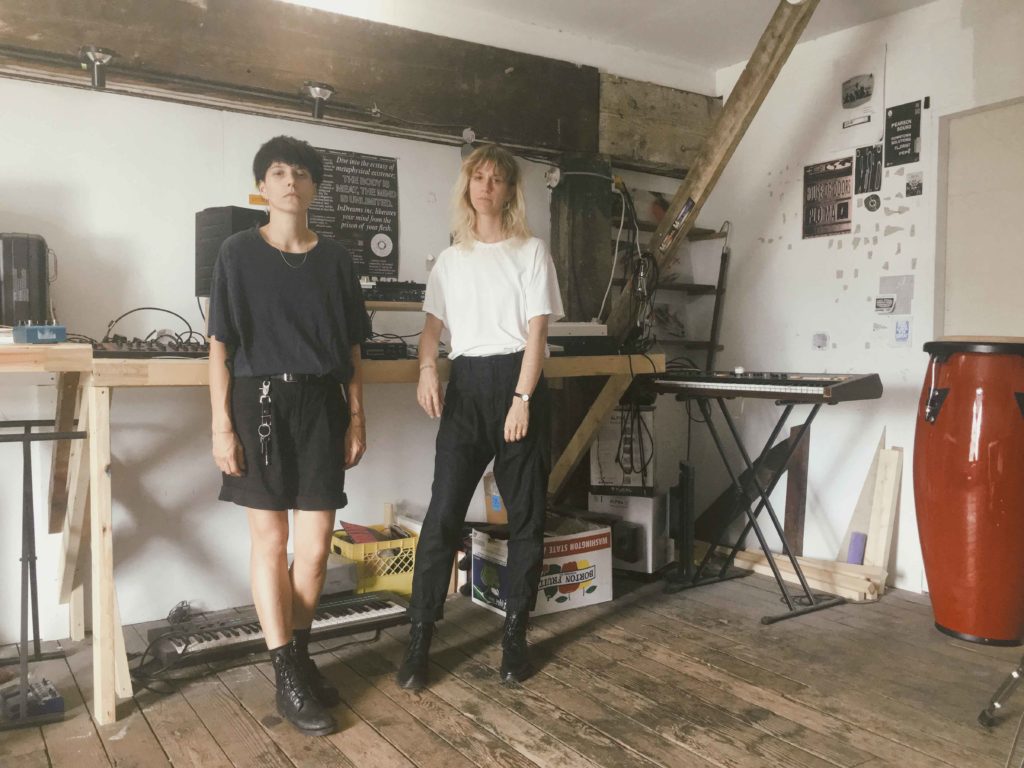
Talk to me about the decision to start Minimal Violence: what inspired you?
We wanted to explore something creative together, and the decision to take a year off drinking gave us plenty of free time and a new focus. Music just seemed natural, although Lida was more involved in the art community so we worked to tie that into the project wherever possible as well. We both enjoyed going out dancing and watching artists perform live and we just wanted to engage more with that community.
“We’re not trying to recreate tracks that have already been done; we’re trying to imagine how we would have approached them at that time. We do this by including some signifiers of a genre while completely disregarding other conventions.”
— Minimal Violence
What was the vision for the project back then?
I don’t know if we had a specific vision when we started; it was more just about learning to use the pieces we had at hand. We both enjoyed artists like Chris and Cosey, Dead Can Dance, Medio Mutante, and others in that realm, and I think at first saw the project going in that direction. We even had vocals on the first few recordings!
That’s a far cry from what you make today. How did your sound evolve?
It might have been influenced by things that we have been listening to over time. I remember the first time we heard Frankie Knuckles’ “Baby Wants to Ride” and being blown away by how it can feel just as dark as an industrial/minimal synth track but still hold the dancefloor in such an intense way. I think that was a huge turning point in when we started further exploring house and techno.
From there on, I feel like our sound has followed a progression that reflects a middle ground between our original influences and what we are currently listening to. We still hold onto certain elements of the sound we were trying to craft originally while incorporating our interpretation of genres we admire, like ‘90s techno, for instance, or UK hardcore. We’re not trying to recreate tracks that have already been done; we’re trying to imagine how we would have approached them at that time. We do this by including some signifiers of a genre while completely disregarding other conventions.
Can you remember specifically when you found a sound aesthetic you liked–when it “clicked?”
I feel like we’ve only recently come into ourselves, but there has definitely been a consistent quality throughout all of the recordings. Some of our earliest work leaned towards the sound being put forth by labels like LA Club Resource, that borderline non-functional grit that is reminiscent of the aesthetic qualities of punk. And our sound, although deliberate, has also always been a product of our limitations. Our choice to work with certain pieces of hardware and focus on an attempt to re-create a live feeling are also defining qualities of our sound aesthetic.
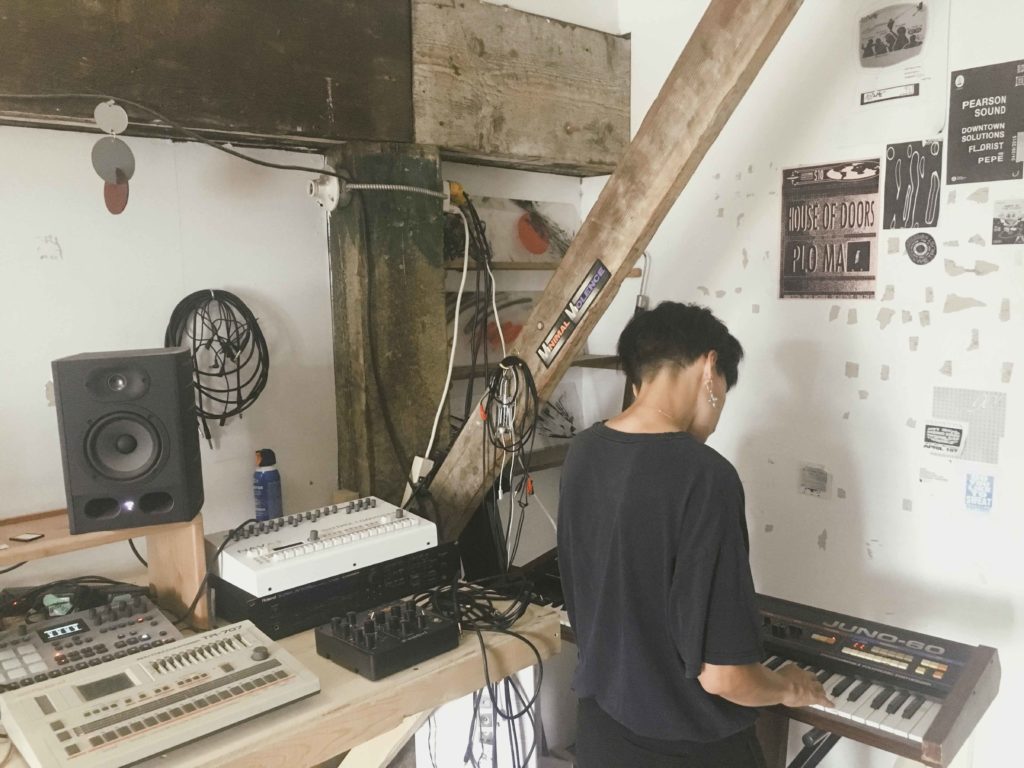
What were your processes like to begin with?
Very much trial and error! We started with just the initial pieces Ashlee already had [from their minimal synth project] and tried to figure out how to work those into a new process that allowed for more layers and overdubs. Up until that point, neither of us knew anything about MIDI so everything was just triggered by the 606 and we could only have pieces that used din sync. (I think this was around the time we acquired the TR707.) The most game-changing part of our process is when we started using an SBX Sync box, as this allowed us to sync all of our din sync pieces to the master clock in Ableton, therefore allowing for multiple overdubs and adding other MIDI-clocked pieces into the mix.
What were your go-to places to learn the more technical side of your processes?
A lot of Google searching. This generally leads us to become voyeurs on forums in search of answers, but oddly we have never actually typed a question into a forum or Reddit, or anything like that. We also found that Attack magazine was a constantly revisited resource, because there are really great tutorials that taught us a lot from the basics to more specific processes.
“Creating gave me something to channel that energy into; instead of needing to go out and get wasted, we can stay in and work on creating something.”
—Ash Luk
How does the satisfaction of electronic music compare to your other artistic endeavours–drawing, for you, Lida, and punk, for you, Ash?
Lida: Drawing and writing are both very much solitary activities that come naturally to me. I don’t actually share the products of them with people often, but I’m trying to change that. With music, I work alongside Ashlee so it is more of a playful process outside of my own head. Additionally, I am forced to be present in the public sphere. I’m more of a shy and reserved person, so performing and playing live is something completely out of character for me. I’ve learned to gain satisfaction from proving to myself that I can do it despite it feeling incredibly uncomfortable at times.
Ash: The satisfaction of punk music is in the visceral nature of the performance, and the response of the crowd, but I also feel like this is something I have actively channeled into Minimal Violence; it’s an attempt to conjure the energy of a pit into a dancefloor. And in some ways, I feel like it’s even more successful in this setting: the dancefloor is less centred around masculine energy than the traditional mosh pit.
Also, in comparison to what I’m used to when playing in bands, electronic music feels like a solitary activity for me. Aside from the obvious parts that are formed on collaboration, there are also the parts that allow for each of us to get lost in the mixes and in our own heads. In addition, I credit electronic music for providing me with an escape from the toxicity of party culture. This kind of seems like the reverse of what most would assume of playing in clubs consistently, but for myself I struggled a lot with drugs and alcohol before starting Minimal Violence; although we play parties and still attend, we now have a different relationship with the culture. Creating gave me something to channel that energy into; instead of needing to go out and get wasted, we can stay in and work on creating something.
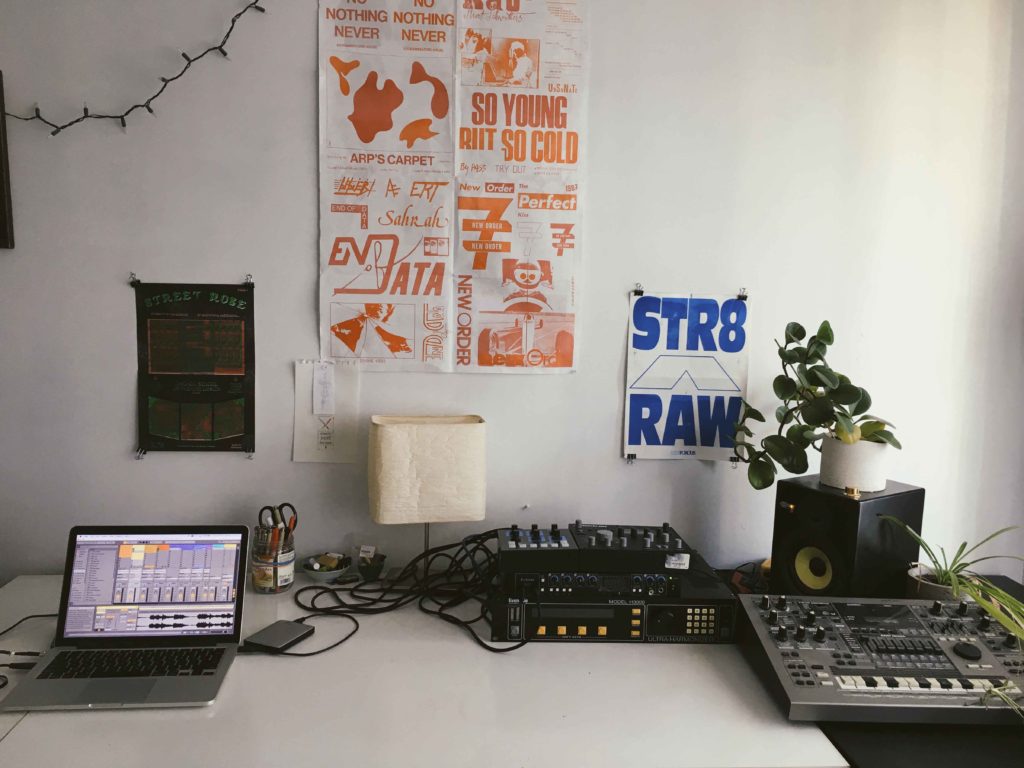
What are the key pieces of gear in your studio nowadays?
The MPC1000 is a vital piece when composing, as is the Arturia Keystep, which we go to often when coming up with synth lines. The Nava 909 is key to all of our recordings as well; it pretty much plays and sounds as close to the real thing as you can get. Another studio favorite is still the Juno 60. It’s the first synth either of us ever owned and it still finds its way onto nearly every track. A recent piece that I find completely indispensable is the Oto BIM: it’s a 12-bit stereo delay and we’ve been tossing it on just about everything. Even just as a sound module, running it through the delay bypass mode gives an amazing warm 12-bit texture to everything it touches.
Are you using Ableton as your master clock and main hub?
When recording, Ableton is the master clock so that we can easily go back in and overdub / layer in new parts. We run directly from Ableton to the SBX so that we can also run sync to the 606 and Juno.
Where do you research your gear?
Articles like this one sometimes, actually the Tzusing one pointed us towards the Soundtoys plug-ins which have been pretty useful when mixing! We also research specific recording techniques/gear used by artists we respect. There’s no specific place for this, but Google will lead us where we need to go. We’ve definitely spent a lot of time looking into ‘90s rave sounds as well as Skinny Puppy and early NiN gear!
How do you strip your setup back for your live performances?
We build our live sets around what can fit into two carry on cases. We always want to be able to bring everything on with us instead of having to check any gear. It’s shifted a bit over the years but some things have always remained, like the MPC1000 and TR707. Those two are crucial to our flow and sound. We had a Nava 909 clone in our setup for a while which was amazing, but those things are glitchy since they are from a build kit so after having it not turn on for a couple of shows we decided to replace it with the Analog RYTM which is one hundred percent reliable and has a bit more flexibility as to what we can do with it. Lida even triggers some of the hoovers and stabs from the RYTM now too. The Virus A is also key to our live sound; most of our synth parts are sent to this and it has such an intuitive workflow for live. Being able to switch through the multi-timbral mode so seamlessly to edit parts on the fly is hugely important to our live set.
Are you using the RYTM for its internal drum voices as well as a sampler?
Just a sampler. To be honest, we just got it to replace the NAVA in our live setup since it was pretty unreliable. So it’s just packed with 909 samples plus some R100 and some stabs and random sample bits. We haven’t really delved too far into the RYTM’s drum synth capabilities, maybe one day, but maybe it’s not really our sound. Like we mentioned, we tend to lean towards units with very characteristic sounds—solid interface and great for messing with sampled bits though!
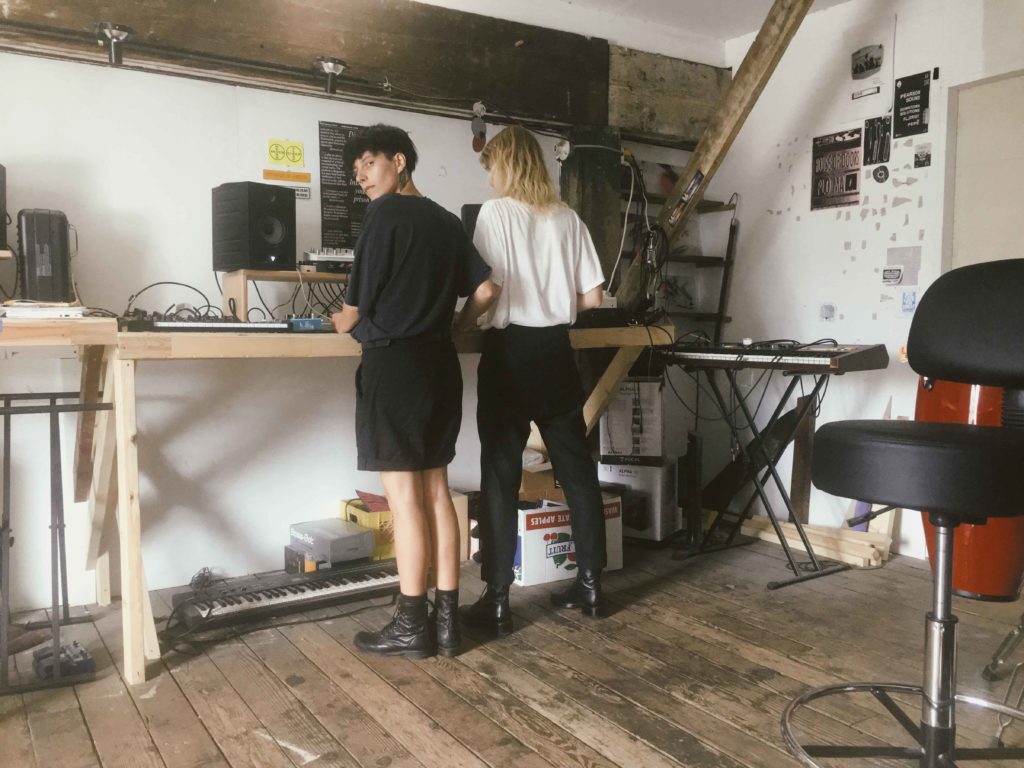
Talk to me about the process for starting a track: is there a set starting point, or is it a jam?
Generally, we start with something we’ve written for the live set. We will play through it together like we would live to try to harness some of that live energy and flow but from there we will use that as the draft and begin piecing everything together. The kick will generally be the only thing we keep from that first run and we’ll go back through and track everything else individually, separating each of the drums onto their own channel, playing each synth part fully through while messing with the parameters to work with the flow of the piece. We will constantly refer back to the first pass as a reference for placement of each part. Once this is all in, we look into elements to add and subtract that differentiate it from its live version. Maybe with some samples, or by replacing a drum part or adding a new synth line. Often after all this is done, we’ll take another look at the piece in the home studio setup and run different parts through effects and send them back into the mix sometimes altering them to the point where they are completely unrecognizable from the original.
But how do you go about forming something for the live set—what’s the process there?
It generally begins with a kick in the MPC, or a few different kick patterns to shift between. From there, generally one of us will come up with a melody and sequence that goes into the MPC (although occasionally if we have a sample we really want to use we will start with that and work the melody in after the fact). Once we have a groove, Lida will start programming all the other drum bits. From there is can really go anywhere. We generally write a few sections to each live track so we shift between different patterns and synth lines while some parts stay continuous.
It’s interesting that neither of you are educated in music. How do you feel this has affected your approach to making and performing music?
We both did 10 years of classical piano training when we were young so we had that as a basis for musicality. But our ignorance of “proper” techniques in electronic music has definitely been a key part of our sound. We’re more focused on creating something that sounds right to us than something that sounds like everything else. This has admittedly at times been a hindrance, mainly because we don’t succinctly fit into any one genre so sometimes we’re hard to identify or people don’t know where to fit us, but most of the time I think it’s worked to our advantage.
What specific areas are you trying to improve at in terms of production?
We’re trying to learn more about the mixing process. We’ve had a few records where we’ve done it completely ourselves and some where we’ve got help from friends/mixing engineers, and we want to get to a point where we are comfortable enough with our own mixing skills and ears that we can confidently get a mix to where we want it and choose whether or not we want to work with someone else for final touches or not. I like working with other people who focus more specifically in this realm as they have a critical approach and an ear for frequency detail that we just don’t. Our focus is on crafting songs and creating a sonic environment.
What sort of feeling are you trying to stir-up in the listener, if anything at all?
Anxiety, tension, unease, But also nostalgia and sentimentality. We don’t want our music to make people comfortable by any means but we do want to make people feel something as opposed to just making cold, atonal music, whether it be functional or not. Often our music is not functional; the textures are too dense to play out or the structure is not catered to the flow of a DJ set. I guess we don’t really write with the DJ in mind, but we do write with the dancefloor in mind; we want the songs to be full of energy, but the type of energy you have in key moments, like the break of dawn.
Do you distribute your latest material to DJs—and what’s the response been?
We do. It seems like people are into it. Although we don’t specifically write with a format in mind that’s catered to DJs, we still hope the tracks get played out, and we love to see videos of people dancing to heavy ones, like “June Anthem.”
How do you spend your time outside of music–professionally and otherwise?
Ash: I’ve recently been focused a lot on tattooing. I’m still learning and have a long way to go but I feel like it’s something that I can see myself continuing alongside music as I progress; it gives me a separate creative outlet to channel energy into which is especially good when I need a break from music. Another recent focus is running and fitness in general. Fitness is especially important when touring in order to stay grounded. It’s a space where I can both clear my head and seek inspiration. I often am dissecting music as I run. I found listening to music problematic when studying in school because I would get distracted analysing each individual part but I feel like this has a positive effect when running because I’ll get so lost in the tracks that I’ll forget about how long I’ve been running. Also, I’ve been slinging coffee for what seems like forever.
Lida: I worked retail at a fancy independent clothing store in Vancouver until the start of this summer. I finally got fired for not being perky enough. I’ve been working on my health a lot this year, part of this involves being more active and getting into running with Ashlee. I’m attempting to stop drinking entirely again, especially when playing shows. I have a mood disorder and anxiety, and I am focusing on trying to figure out how to manage them both on my own terms and while touring. As mentioned, I draw and write as well. I read a lot too.

